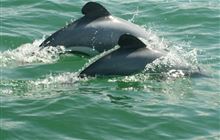Research on Hector’s and Māui dolphin
Introduction
Research and scientific studies are essential to better understand these dolphins and support the long-term recovery of their populations.We work with university researchers and conservation organisations to find out more about the dolphins, the threats they face and how best to manage the threats.
Research includes work to better understand the biology of the animals and the way they use their environment, including their abundance, distribution, behaviour and diet.
Research can help answers questions like:
- Can the population of Māui dolphin recover and if so, how long will it take?
- How are dolphin populations affected by the ways we use the marine environment? Such as, seabed mining, seismic surveying and coastal development?
- Can Māui dolphin and Hector's dolphin interbreed?
- How can the threats from toxoplasmosis be managed and reduced?
Hector's and Māui dolphin Research Strategy 2021
The purpose of the Hector’s and Māui dolphin Research Strategy is to support the vision and goals of the Hector’s and Māui Dolphin Threat Management Plan (TMP).
Gathering more information on Hector’s and Māui dolphins and the threats impacting them is crucial to ensuring the actions implemented under the TMP are appropriate and lead to the dolphins thriving and recovering.
Hector's and Māui dolphin Research Strategy 2021 (PDF, 712K)
Hector’s and Māui dolphin current research projects
Spreadsheet showing current Hector's and Māui dolphin research (XLSX, 14K)
Dolphin sightings
As part of our research, we record sightings of Hector’s and Māui dolphins to better understand their distribution.
Other research
- Māui dolphin abundance estimate
- Māui dolphin location surveys
- Māui dolphin toxicology and disease research
Publications related to Hector’s and Māui dolphin
Bibliographies
- An updated, annotated bibliography for Hector's (Cephalorhynchus hectori hectori) and Māui (C. hectori maui) dolphins (PDF, 431K)
- 2012 bibliography for Hector's and Maui dolphins. DOC. (PDF, 2,290K)
- 2003 bibliography for Hector's dolphin. DOC. (PDF, 165K)
Threat research
- Improving age estimation for Hector's and Māui dolphins (PDF, 416K)
- New Zealand Cetacean Tissue Archive July 2021 - June 2022 final report (PDF, 183K)
- Investigating the diet of Hector's dolphins from the top of the South Island with stable isotope analysis (PDF, 2,756K)
- High quality DNA extraction for advanced genetic analysis (PDF, 748K)
- Population effects of fishery and non-fishery threats on Māui dolphin (2019) (PDF, 665K)
- Underwater sound propagation modelling to illustrate potential noise exposure to Māui dolphin from seismic surveys and vessel traffic on West Coast North Island (2019) (PDF, 7,630K)
- Potential impacts of petroleum and minerals exploration and production on Hector’s and Māui dolphins (2019) (PDF, 6,286K)
- Review of Hector’s and Māui dolphin diet, nutrition and potential mechanisms of nutritional stress (2018) (PDF, 816K)
Submissions to the International Whaling Commission Scientific Committee
Dolphin distribution and occurrence
- Hector's dolphin genetic analysis update - 2022 (PDF, 441K)
- Distribution of Maui dolphin 2000–2009. (PDF, 165K)
Preliminary reports on dolphin occurrence using acoustic recording devices in:
- coastal areas of Hamilton’s Gap, Manukau Harbour, Taranaki and Wanganui River: deployment 1 (2018) (PDF, 1,764K)
- coastal waters of Taranaki: deployment 2 (2018) (PDF, 1,032K)
- coastal waters of Manukau and Taranaki: deployment 2 (2018) (PDF, 1,379K)



